MERCEDES-BENZ E-Class CABRIOLET 2014 C207 Owner's Manual
Manufacturer: MERCEDES-BENZ, Model Year: 2014, Model line: E-Class CABRIOLET, Model: MERCEDES-BENZ E-Class CABRIOLET 2014 C207Pages: 394, PDF Size: 5.28 MB
Page 371 of 394

Securing the vehicle on slight downhill gradients
(example: Coupe)
X On light downhill gradients: place
chocks or other suitable items in front of
the wheels of the front and rea raxle.
Raising the vehicle G
WARNING
If you do not positio nthe jack correctly at the
appropriate jacking point of the vehicle, the
jack could tip over with the vehicle raised.
There is a risk of injury.
Only position the jack at the appropriate
jacking point of the vehicle. The base of the
jack must be positioned vertically, directly
under the jacking point of the vehicle.
! The jack is designed exclusively for
jacking up the vehicle at the jacking points.
Otherwise, your vehicle could be damaged.
Observe the following when raising the
vehicle:
R to raise the vehicle, only use the vehicle-
specific jack that has been tested and
approved by Mercedes-Benz. If used
incorrectly, the jack could tip over with the
vehicle raised.
R the jack is designed only to raise and hold
the vehicle for a short time while a wheel
is being changed. It is not suited for
performing maintenance work under the
vehicle.
R avoid changing the wheel on uphill and
downhill slopes. R
before raising the vehicle, secure it from
rolling away by applying the parking brake
and inserting wheel chocks. Never
disengage the parking brake while the
vehicle is raised.
R the jack must be placed on a firm, flat and
non-slip surface. On a loose surface, a
large, load-bearing underlay must be used.
On a slippery surface, a non-slip underlay
must be used, e.g. rubber mats.
R do not use wooden blocks or similar
objects as a jack underlay.O therwise, the
jac kw ill not be able to achieve its load-
bearing capacity due to the restricted
height.
R make sure that the distance between the
underside of the tires and the ground does
not exceed 1.2 in (3 cm).
R never place your hands and feet under the
raised vehicle.
R never lie under the raised vehicle.
R never start the engine when the vehicle is
raised.
R never open or close a door or the trunk lid
when the vehicle is raised.
R make sure that no persons are present in
the vehicle when the vehicle is raised. X
Using lug wrench 0002, loosen the bolts on
the wheel you wish to change by about one
full turn. Do not unscrew the bolts
completely. Changing
awheel
369Wheels and tires Z
Page 372 of 394

Jacking points (example: Coupe)
The jacking points are located jus
tbehind the
front wheel housings and just in front of the
rear wheel housings (arrows).
Vehicles with AMG equipment: to protect
the vehicle body, the vehicle has covers next
to the jacking points on the outer sills. X
Vehicles with AMG equipment: fold
cover 0003upwards. X
Position jack 0022at jacking point 0023. Example
X
Make sure the foot of the jack is directly
beneath the jacking point.
X Turn crank 0020clockwise until jack 0022sits
completely on jacking point 0023and the
base of the jack lies evenly on the ground.
X Turn crank 0020until the tire is raised a
maximum of 1.2 in (3 cm) off the ground.
Removing awheel !
Do not place wheel bolts in sand or on a
dirty surface. The bol tand wheel hub
threads could otherwise be damaged when
you screw them in. X
Unscrew the uppermost wheel bolt
completely.
X Screw alignment bolt 0002into the thread
instead of the wheel bolt.
X Unscrew the remaining whee lbolts fully.
X Remove the wheel. 370
Changing
awheelWheels and tires
Page 373 of 394

Mounting
anew wheel G
WARNING
Oiled or greased wheel bolts or damaged
wheel bolts/hub threads can cause the wheel
bolts to come loose .As a result, you could
lose a wheel while driving. There is a risk of
accident.
Never oil or grease wheel bolts. In the event
of damage to the threads, contact a qualified
specialist workshop immediately.H ave the
damaged wheel bolts or hub threads
replaced/renewed. Do no tcontinue driving. G
WARNING
If you tighten the wheel bolts or wheel nuts
when the vehicle is raised, the jack could tip
over. There is a risk of injury.
Only tighten the wheel bolts or wheel nuts
when the vehicle is on the ground.
Always pay attention to the instructions and
safety notes in the "Changing a wheel"
section (Y page 367).
Only use wheel bolts that have been designed
for the wheel and the vehicle. For safety
reasons, Mercedes-Benz recommends that
you only use wheel bolts which have been
approved for Mercedes-Benz vehicles and the
respective wheel.
! To prevent damage to the paintwork, hold
the wheel securely against the wheel hub
while screwing in the first wheel bolt. Positioning a wheel (example: vehicle with an
emergency spare wheel) X
Clean the wheel and wheel hub contact
surfaces.
X Slide the wheel to be mounted onto the
alignment bolt and push it on.
X Tighten the wheel bolts until they are
finger-tight.
X Unscrew the alignment bolt.
X Tighten the last wheel bolt until it is finger-
tight.
Lowering the vehicle G
WARNING
The wheels could work loose if the wheel nuts
and bolts are not tightened to the specified
tightening torque. There is a risk of accident.
Have the tightening torque immediately
checked at a qualified specialist workshop
after a wheel is changed. Tightening the wheel nuts (example: vehicle with
an emergency spare wheel)
X
Turn the crank of the jack counter-
clockwise until the vehicle is once again
standing firmly on the ground.
X Place the jack to one side.
X Tighten the wheel bolts evenly in a
crosswise pattern in the sequence
indicated (0002 to0020). The specified
tightening torque is 96 lb-ft(130 Nm).
X Turn the jack back to its initial position.
X Stow the jack and the rest of the vehicle
tools in the trunk again. Changing
awheel
371Wheels and tires Z
Page 374 of 394
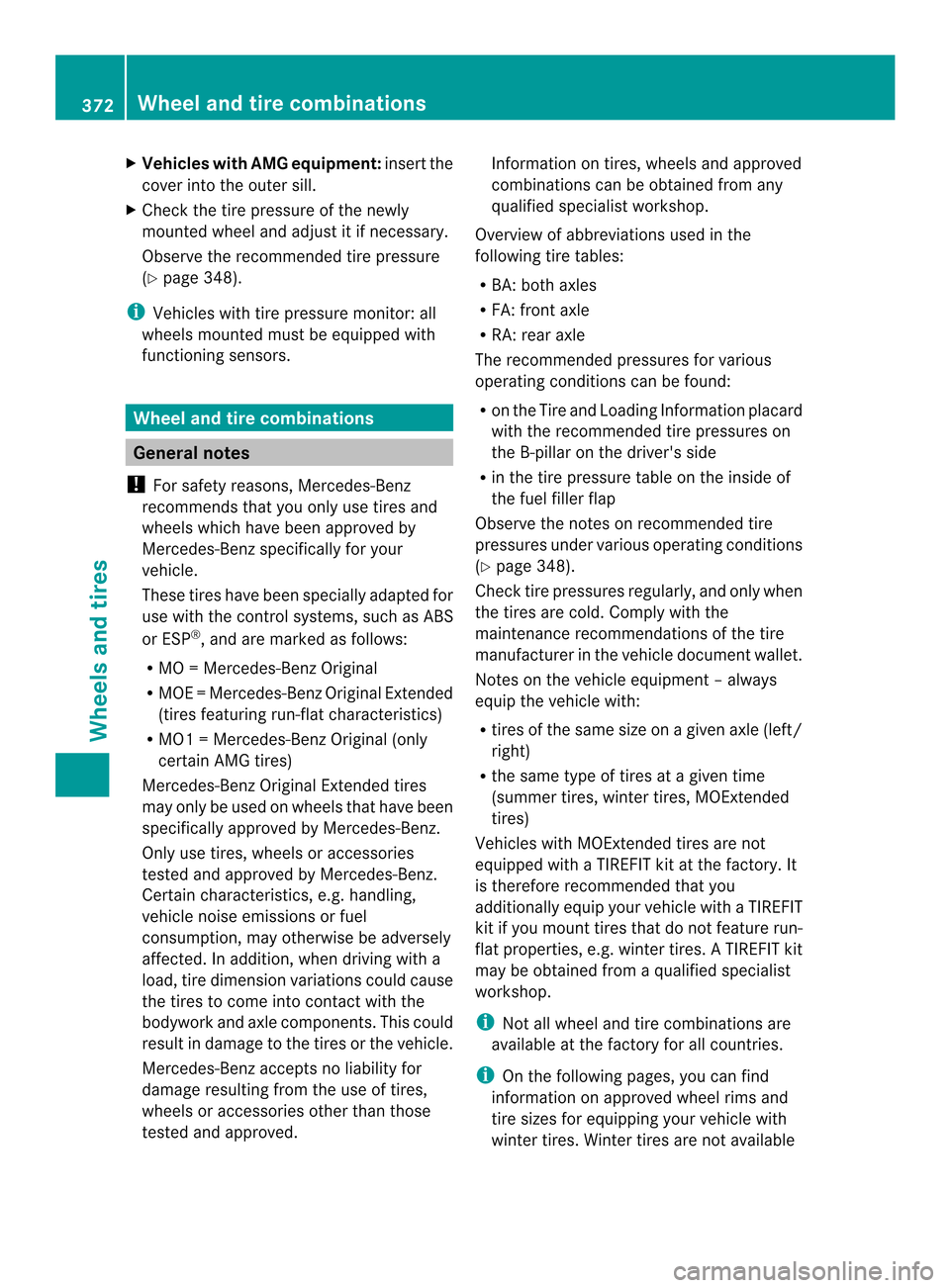
X
Vehicles with AMG equipment: insert the
cove rinto the outer sill.
X Check the tire pressure of the newly
mounted wheel and adjus titifnecessary.
Observe the recommended tire pressure
(Y page 348).
i Vehicles with tire pressure monitor: all
wheels mounted must be equipped with
functioning sensors. Wheel and tire combinations
General notes
! For safety reasons, Mercedes-Benz
recommends that you only use tires and
wheels which have been approved by
Mercedes-Benz specifically for your
vehicle.
These tires have been specially adapted for
use with the control systems, such as ABS
or ESP ®
, and are marked as follows:
R MO =Mercedes-BenzO riginal
R MOE =Mercedes-BenzO riginal Extended
(tires featuring run-flat characteristics)
R MO1 =Mercedes-Benz Original (only
certain AMG tires)
Mercedes-BenzO riginal Extended tires
may only be used on wheels that have been
specifically approved by Mercedes-Benz.
Only use tires, wheels or accessories
tested and approved by Mercedes-Benz.
Certain characteristics, e.g. handling,
vehicle noise emissions or fuel
consumption, may otherwise be adversely
affected. In addition, when driving with a
load, tire dimension variations could cause
the tires to come into contact with the
bodywork and axle components. This could
result in damage to the tires or the vehicle.
Mercedes-Benz accepts no liability for
damage resulting from the use of tires,
wheels or accessories other than those
tested and approved. Information on tires, wheels and approved
combinations can be obtained from any
qualified specialist workshop.
Overview of abbreviations usedint he
following tire tables:
R BA: both axles
R FA: front axle
R RA: rear axle
The recommended pressures for various
operating conditions can be found:
R on the Tire and Loading Information placard
with the recommended tire pressures on
the B-pillar on the driver's side
R in the tire pressure table on the inside of
the fuel filler flap
Observe the notes on recommended tire
pressures under various operating conditions
(Y page 348).
Check tire pressures regularly, and only when
the tires are cold. Comply with the
maintenance recommendations of the tire
manufacturer in the vehicle document wallet.
Notes on the vehicle equipment –always
equip the vehicle with:
R tires of the same size on a given axle (left/
right)
R the same type of tires at a given time
(summer tires, winter tires, MOExtended
tires)
Vehicles with MOExtended tires are not
equipped with a TIREFIT kit at the factory. It
is therefore recommended that you
additionally equip your vehicle with a TIREFIT
kit if you moun ttires that do not feature run-
flat properties, e.g. winter tires. ATIREFIT kit
may be obtained from a qualified specialist
workshop.
i Not all wheel and tire combinations are
available at the factory for all countries.
i On the following pages, you can find
information on approved wheelr ims and
tire sizes for equipping your vehicle with
winter tires. Winter tires are not available 372
Wheel and tire combinationsWheels and tires
Page 375 of 394
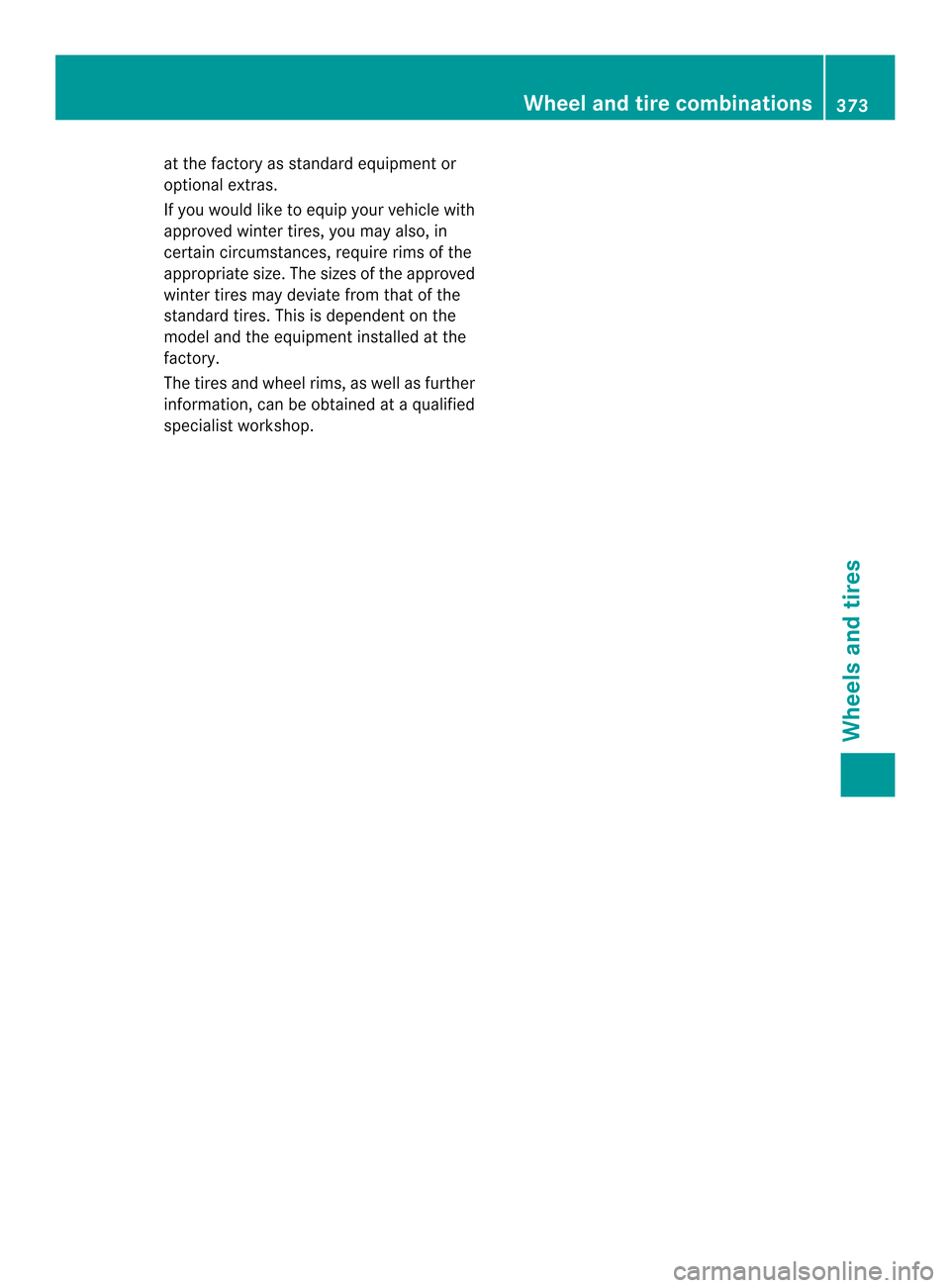
at the factory as standard equipmen
tor
optional extras.
If you would like to equip your vehicle with
approved winter tires, you may also, in
certain circumstances, require rims of the
appropriate size. The sizes of the approved
winter tires may deviate from that of the
standard tires. This is dependent on the
model and the equipment installed at the
factory.
The tires and wheel rims, as well as further
information, can be obtained at a qualified
specialist workshop. Wheel and tire combinations
373Wheels and tires Z
Page 376 of 394
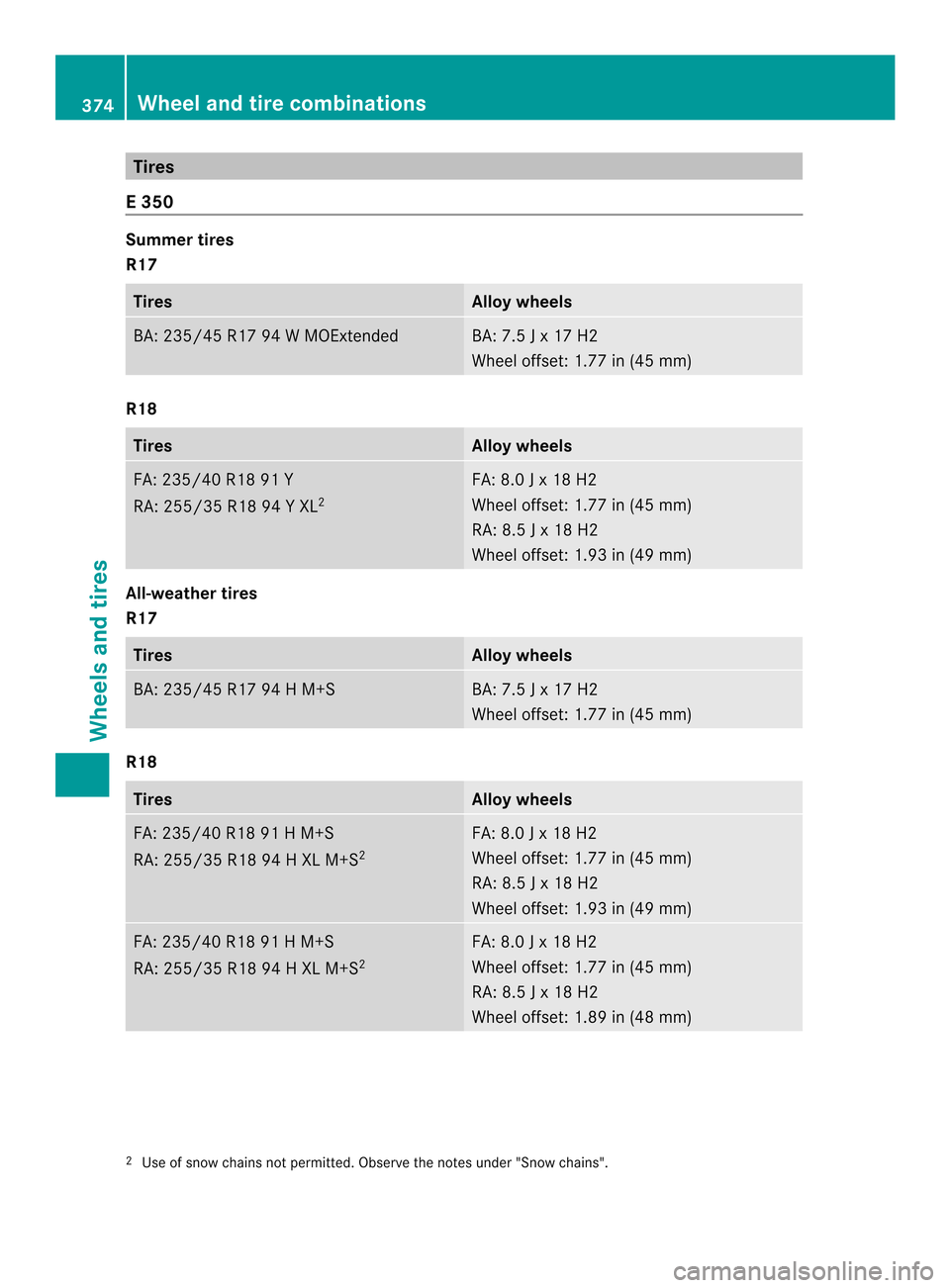
Tires
E 350 Summer tires
R17
Tires Allo
ywheels BA: 235/45 R17 94 W MOExtended BA: 7.5 J x 17 H2
Wheel offset: 1.77 in (45 mm) R18
Tires Alloy wheels
FA: 235/40 R18 91 Y
RA: 255/35 R18 94 Y XL
2 FA: 8.0 J x 18 H2
Wheel offset: 1.77 in (45 mm)
RA: 8.5 J x 18 H2
Wheel offset: 1.93 in (49 mm) All-weather tires
R17
Tires Alloy wheels
BA: 235/45 R17 94 H M+S BA: 7.5 J x 17 H2
Wheel offset: 1.77 in (45 mm) R18
Tires Alloy wheels
FA: 235/40 R18 91 H M+S
RA: 255/35 R18 94 H XL M+S
2 FA: 8.0 J x 18 H2
Wheel offset: 1.77 in (45 mm)
RA: 8.5 J x 18 H2
Wheel offset: 1.93 in (49 mm) FA: 235/40 R18 91 H M+S
RA: 255/35 R18 94 H XL M+S
2 FA: 8.0 J x 18 H2
Wheel offset: 1.77 in (45 mm)
RA: 8.5 J x 18 H2
Wheel offset: 1.89 in (48 mm) 2
Use of snow chains not permitted. Observe the notes under "Snow chains". 374
Wheel and tire combinationsWheels and tires
Page 377 of 394
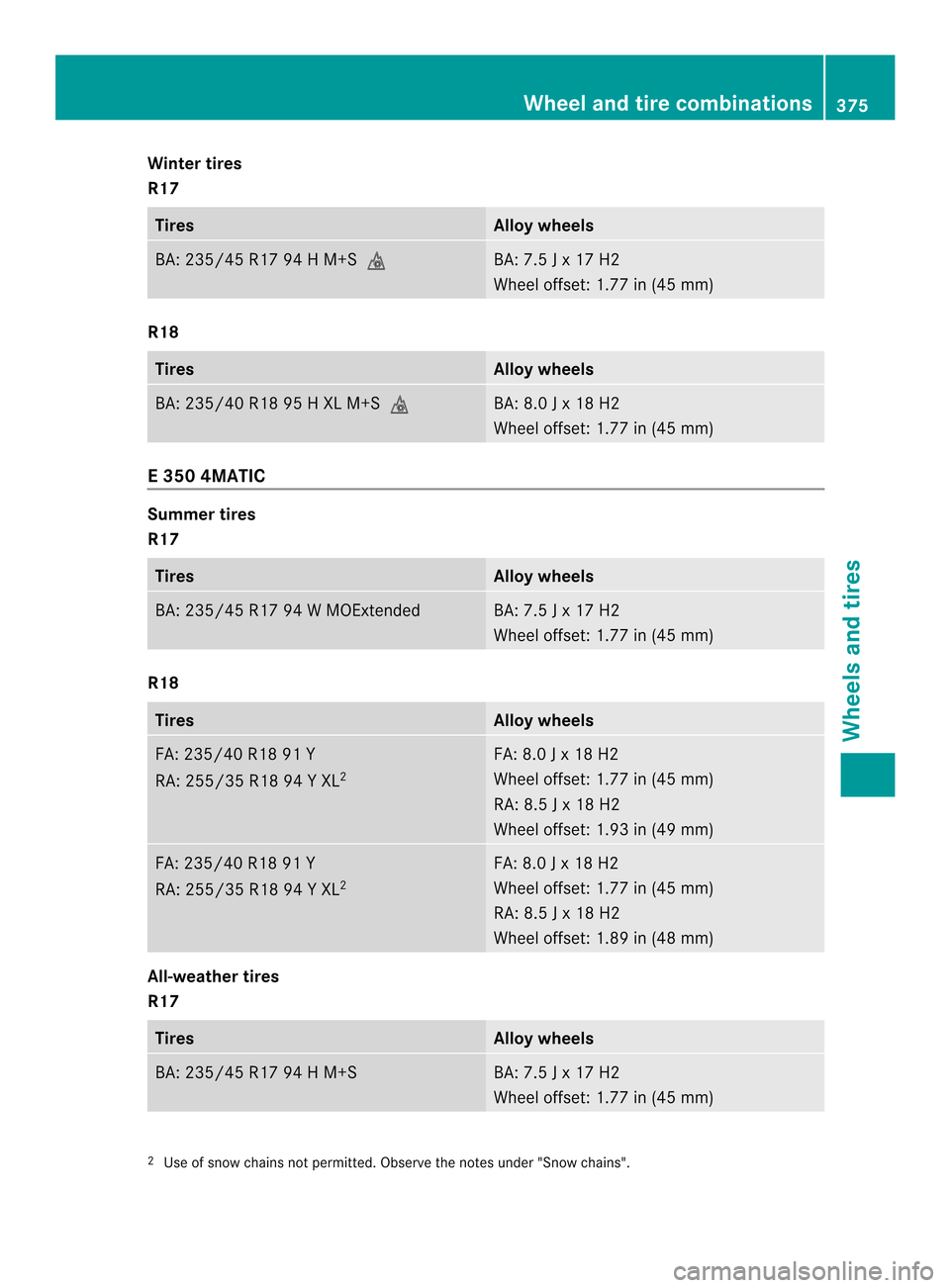
Winter tires
R17
Tires Alloy wheels
BA: 235/45 R17 94 H M+S
0003 BA: 7.5 J x 17 H2
Wheel offset: 1.77 in (45 mm)
R18
Tires Alloy wheels
BA: 235/40 R18 95 H XL M+S
0003 BA: 8.0 J x 18 H2
Wheel offset: 1.77 in (45 mm)
E 350 4MATIC
Summer tires
R17
Tires Alloy wheels
BA: 235/45 R17 94 W MOExtended BA: 7.5 J x 17 H2
Wheel offset: 1.77 in (45 mm)
R18
Tires Alloy wheels
FA: 235/40 R18 91 Y
RA: 255/35 R18 94 Y XL
2 FA: 8.0 J x 18 H2
Wheel offset: 1.77 in (45 mm)
RA: 8.5 J x 18 H2
Wheel offset: 1.93 in (49 mm)
FA: 235/40 R18 91 Y
RA: 255/35 R18 94 Y XL
2 FA: 8.0 J x 18 H2
Wheel offset: 1.77 in (45 mm)
RA: 8.5 J x 18 H2
Wheel offset: 1.89 in (48 mm)
All-weather tires
R17
Tires Alloy wheels
BA: 235/45 R17 94 H M+S BA: 7.5 J x 17 H2
Wheel offset: 1.77 in (45 mm)
2
Use of snow chains not permitted. Observe the notes under "Snow chains". Wheel and tire combinations
375Wheels and tires Z
Page 378 of 394
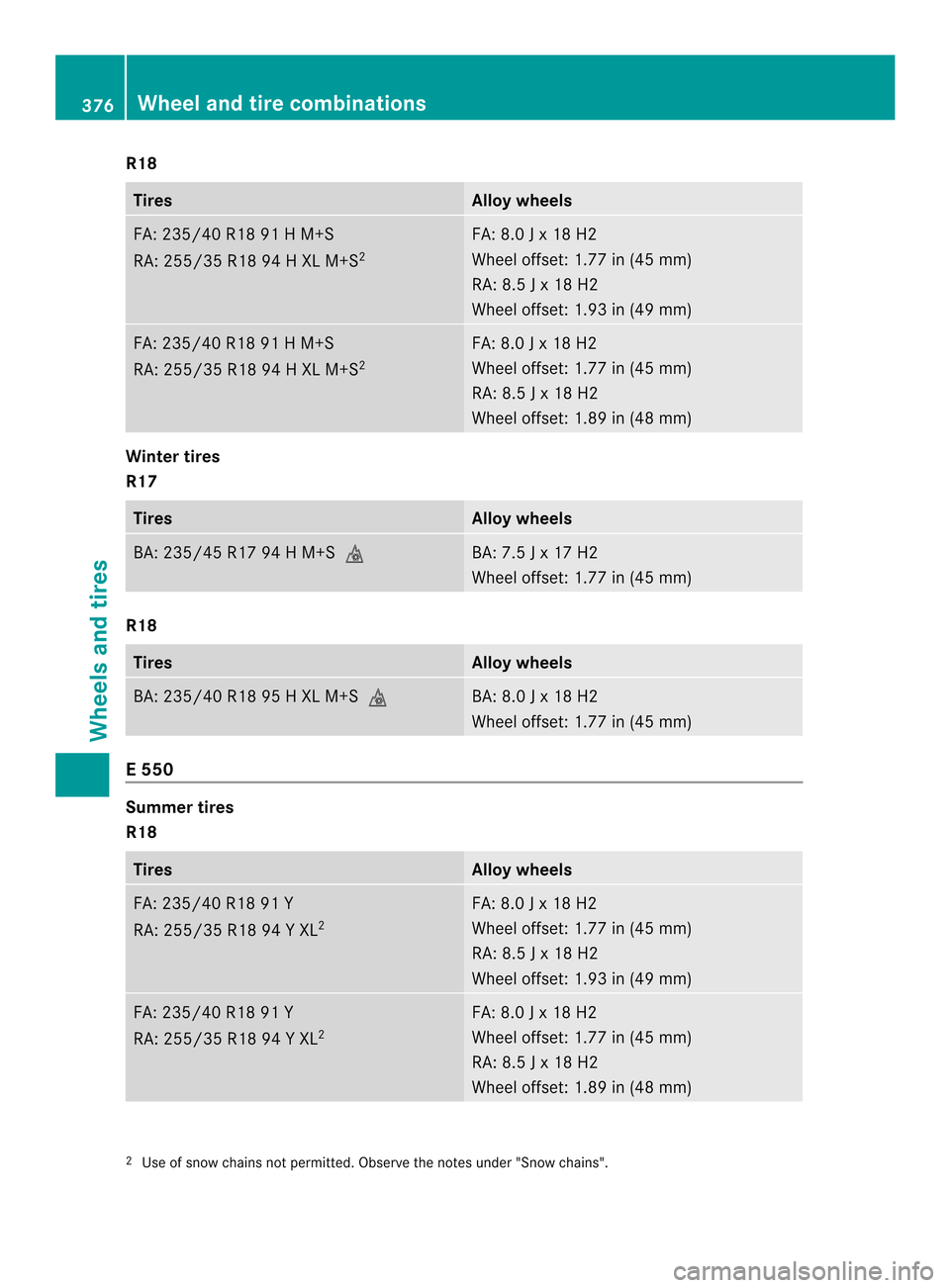
R18
Tires Allo
ywheels FA: 235/40 R18 91 H M+S
RA: 255/35 R18 94 H XL M+S
2 FA: 8.0 J x 18 H2
Wheel offset: 1.77 in (45 mm)
RA: 8.5 J x 18 H2
Wheel offset: 1.93 in (49 mm) FA: 235/40 R18 91 H M+S
RA: 255/35 R18 94 H XL M+S
2 FA: 8.0 J x 18 H2
Wheel offset: 1.77 in (45 mm)
RA: 8.5 J x 18 H2
Wheel offset: 1.89 in (48 mm) Winter tires
R17 Tires Alloy wheels
BA: 235/45 R17 94 H M+S
0003 BA: 7.5 J x 17 H2
Wheel offset: 1.77 in (45 mm) R18
Tires Alloy wheels
BA: 235/40 R18 95 H XL M+S
0003 BA: 8.0 J x 18 H2
Wheel offset: 1.77 in (45 mm) E 550
Summer tires
R18
Tires Alloy wheels
FA: 235/40 R18 91 Y
RA: 255/35 R18 94 Y XL
2 FA: 8.0 J x 18 H2
Wheel offset: 1.77 in (45 mm)
RA: 8.5 J x 18 H2
Wheel offset: 1.93 in (49 mm) FA: 235/40 R18 91 Y
RA: 255/35 R18 94 Y XL
2 FA: 8.0 J x 18 H2
Wheel offset: 1.77 in (45 mm)
RA: 8.5 J x 18 H2
Wheel offset: 1.89 in (48 mm) 2
Use of snow chains not permitted. Observe the notes under "Snow chains". 376
Wheel and tire combinationsWheels and tires
Page 379 of 394
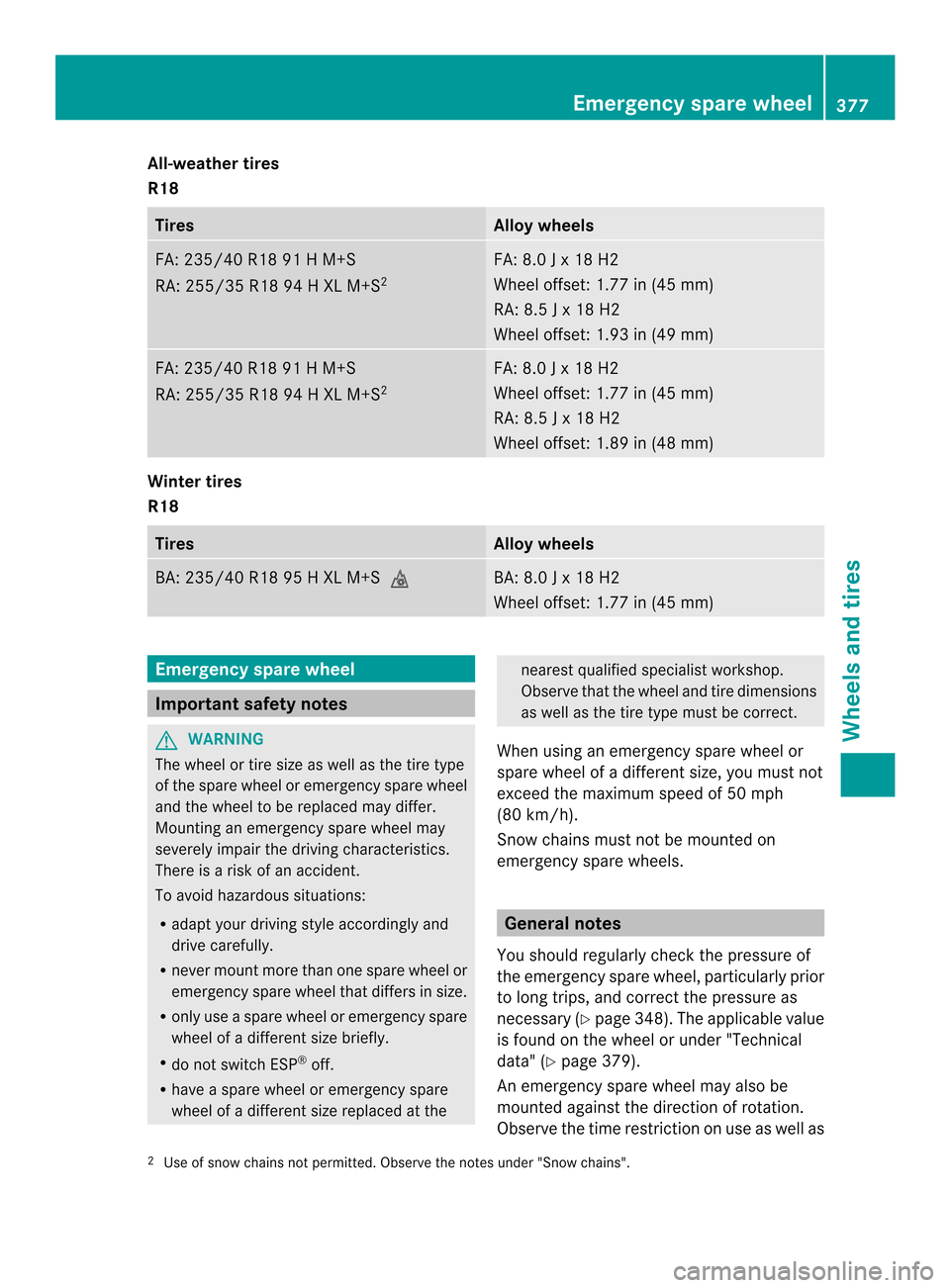
All-weather tires
R18
Tires Alloy wheels
FA: 235/40 R18 91 H M+S
RA: 255/35 R18 94 H XL M+S
2 FA: 8.0 J x 18 H2
Wheel offset: 1.77 in (45 mm)
RA: 8.5 J x 18 H2
Wheel offset: 1.93 in (49 mm) FA: 235/40 R18 91 H M+S
RA: 255/35 R18 94 H XL M+S
2 FA: 8.0 J x 18 H2
Wheel offset: 1.77 in (45 mm)
RA: 8.5 J x 18 H2
Wheel offset: 1.89 in (48 mm) Winter tires
R18
Tires Alloy wheels
BA: 235/40 R18 95 H XL M+S0003 BA: 8.0 J x 18 H2
Wheel offset: 1.77 in (45 mm)
Emergency spare wheel
Important safety notes
G
WARNING
The wheel or tire size as well as the tire type
of the spare wheel or emergency spare wheel
and the wheel to be replace dmay differ.
Mounting an emergency spar ewheel may
severely impair the driving characteristics.
There is a risk of an accident.
To avoid hazardous situations:
R adapt your driving style accordingly and
drive carefully.
R never mount more than one spare wheel or
emergency spare wheel that differs in size.
R only use a spare wheel or emergency spare
wheel of a different size briefly.
R do not switch ESP ®
off.
R have a spare wheel or emergency spare
wheel of a different size replaced at the nearest qualified specialist workshop.
Observe that the wheel and tire dimensions
as well as the tire type must be correct.
When using an emergency spare wheel or
spare wheel of a different size, you must not
exceed the maximum speed of 50 mph
(80 km/h).
Snow chains must not be mounted on
emergency spare wheels. General notes
You should regularly check the pressure of
the emergency spare wheel, particularly prior
to long trips, and correct the pressure as
necessary (Y page 348). The applicable value
is found on the wheel or under "Technical
data" (Y page 379).
An emergency spare wheel may also be
mounted against the direction of rotation.
Observe the time restriction on use as well as
2 Use of snow chains not permitted. Observe the notes under "Snow chains". Emergency spare wheel
377Wheels and tires Z
Page 380 of 394
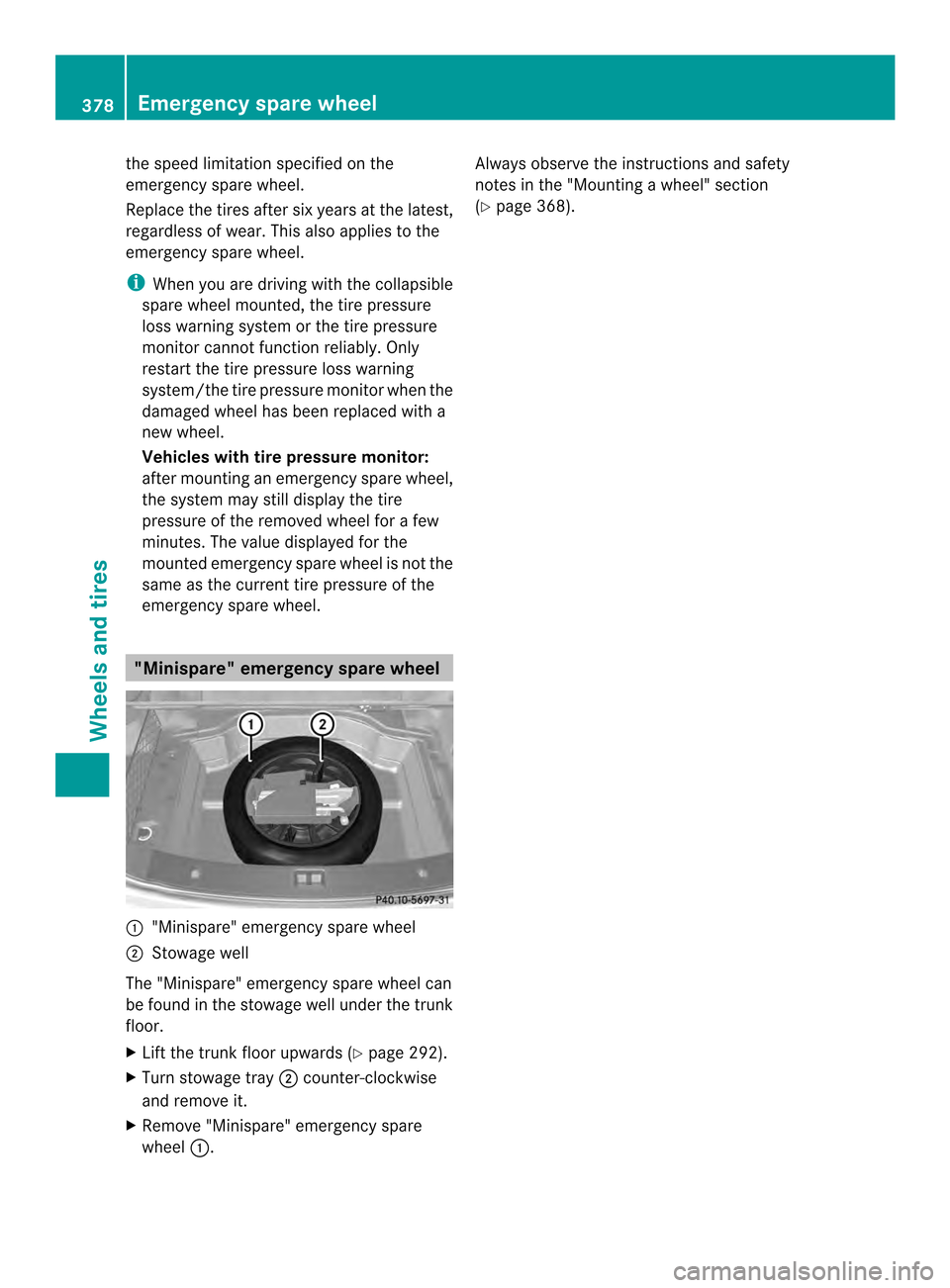
the speed limitation specified on the
emergency spare wheel.
Replace the tires after si
xyears at the latest,
regardless of wear. This also applies to the
emergency spare wheel.
i When you are driving with the collapsible
spare wheel mounted, the tire pressure
loss warning system or the tire pressure
monitor cannot function reliably. Only
restart the tire pressure loss warning
system/the tire pressure monitor when the
damaged wheel has been replaced with a
new wheel.
Vehicles with tire pressure monitor:
after mounting an emergency spare wheel,
the system may still display the tire
pressure of the removed wheel for a few
minutes. The value displayed for the
mounted emergency spare wheel is not the
same as the current tire pressure of the
emergency spare wheel. "Minispare" emergency spare wheel
0002
"Minispare" emergency spare wheel
0003 Stowage well
The "Minispare" emergency spare wheel can
be found in the stowage well under the trunk
floor.
X Lift the trunk floor upwards (Y page 292).
X Turn stowage tray 0003counter-clockwise
and remove it.
X Remove "Minispare" emergency spare
wheel 0002. Always observe the instructions and safety
notes in the "Mounting
awheel" section
(Y page 368). 378
Emergency spare wheelWheels and tires